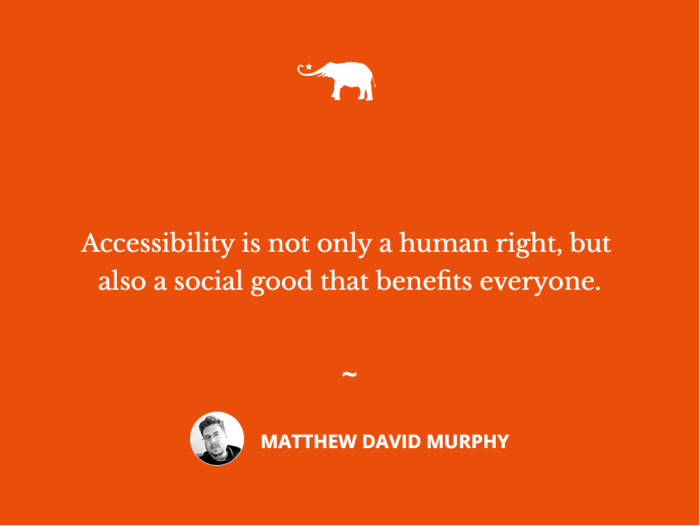*Editor’s Note: We at Elephant invite you to write and share your story of accessibility, or lack thereof, in order to bring more awareness to this important issue of inclusion for all. By sharing our personal stories we humanize the problem, are better able to face it, and bring about change when change is needed. Submit your story to Elephant Journal at elephantjournal.com/post and share on your social networks with the hashtag #GAAD, and tag Elephant Journal so that we can share as well.
Global Accessibility Awareness Day (GAAD) is an annual event that aims to raise awareness and promote digital accessibility and inclusion for people with disabilities and impairments.
GAAD was launched in 2012 by web developer Joe Devon and accessibility professional Jennison Asuncion, and it is celebrated on the third Thursday of May every year. This year, GAAD will take place on May 18, 2023.
How is accessibility different from disability?
A common question, and an understandable one.
Accessibility and disability are related but not synonymous concepts. Disability is a social construct that describes the mismatch between a person’s abilities and the environment or context they are in. Accessibility is a quality attribute that measures how well a product or service can accommodate the needs and preferences of different users, including those with disabilities.
Accessibility can reduce or eliminate barriers that prevent people from participating fully in society.
Participating in GAAD can help promote accessibility for all. I encourage you to join the global movement of GAAD and learn more about digital accessibility and inclusion.
What is digital accessibility?
Digital accessibility means that websites, apps, software, and other digital products are designed and developed in a way that allows everyone, including people with disabilities and impairments, to use them effectively and independently. Digital accessibility covers different aspects of user experience, such as:
-
- Visual: how the content is presented on the screen, whether it has enough contrast, whether it can be enlarged or adjusted, whether it has alternative text for images, etc.
- Auditory: how the content is delivered through sound, whether it has captions or transcripts for audio or video, whether it has sign language interpretation, etc.
- Motor: how the content can be interacted with, whether it can be accessed with a keyboard or other input devices, whether it has clear and consistent navigation, whether it has focus indicators, etc.
- Cognitive: how the content is organized and structured, whether it has clear and simple language, whether it has headings and landmarks, whether it has feedback and error messages, etc.
Check out a few ways to get involved:
- Attend an online or in-person event hosted by various organizations and institutions around the world. You can find a list of events on the official GAAD website or on other websites such as Accessible U or It’s Your Yale.
- Host your own event or activity to share your knowledge and experience with others. You can submit your event to the GAAD website or use social media platforms such as Twitter or Facebook to spread the word. Use the hashtag #GAAD to help others find your posts.
- Participate in online challenges, initiatives, or projects that aim to improve digital accessibility and inclusion. For example, you can take part in the WebAIM Million Report Challenge to help reduce accessibility errors on the web, or you can join the GAAD Foundation to support its mission of disrupting the culture of technology and digital product development to include accessibility as a core requirement.
- Learn more about digital accessibility and inclusion by reading articles, blogs, podcasts, videos, or books on the topic. You can also take online courses or workshops to enhance your skills and knowledge. Some resources you can check out are:
-
- WebAIM: Web Accessibility In Mind
- W3C: Web Accessibility Initiative (WAI)
- A11y Project: A community-driven effort to make web accessibility easier
- Deque University: Online courses on web and mobile accessibility
- Teach Access: A collaboration between education and industry to promote accessible design and development in higher education
Accessibility is not only a human right but also a social good that benefits everyone.
By making our digital lives more accessible and inclusive, we can reach more people across different demographics, offer more personalized experiences, improve usability, step up our game by more fully complying with accessibility laws and regulations, and foster the innovation and creativity of all by embracing inclusion and diversity.
Global Accessibility Awareness Day 2023 is a great opportunity to celebrate the achievements and progress made in digital accessibility and inclusion, as well as to reflect on the challenges and opportunities ahead. Let’s join together to make the digital world more accessible and inclusive for everyone.













Read 0 comments and reply